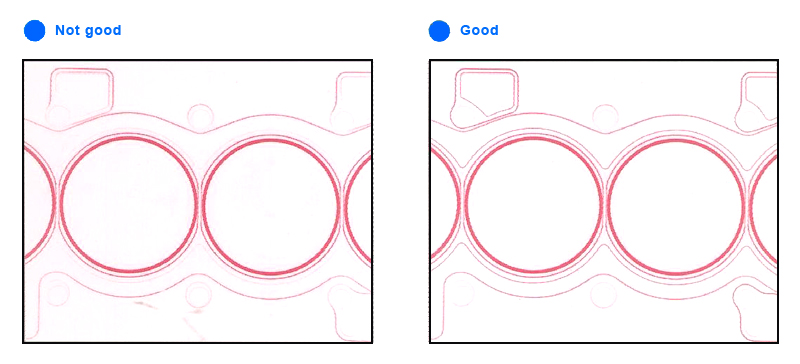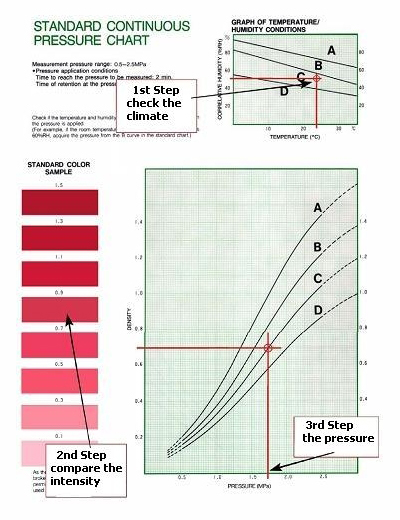Principle
The Prescale films are produced as a 1 – and/or 2-layer film. The 2-layer types have micro-capsules applied on one foil and on the other film is the developer layer. To measure the matte layer side of the film are facing each other - the shiny side of the polyester film has to show to the outside. Each of the two films has a thickness of about 90 microns and can be cut with scissors to the desired size.
With increasing load, no reaction will appear in any given film type and then if the load increases and the first micro-capsules burst, the developer layer at the 2-layer film become slightly reddish. With further load increase, more micro-capsules will burst. This continues until all the capsules have burst, which leads then to a dark red colour of the developer layer. The intensity of the red colour thus provides a measure of the surface pressure. (-> Principle)
Since the microcapsule layer is no longer needed after the measurement, the developer layer provides a non-erasable document. (-> Principle)
At the 1-layer film the colour forming micro-capsules and the developer are on the same slide. Under a defined pressure load, the capsules burst and discolour the film proportional to the load. Thus, you only have to put a single film with thickness 0.11 mm between the components to be investigated, which leads to measurements that are more accurate over the 2-layer type.
However, at risk of pollution (oil, chemicals or moisture), an enclosed second crystal-clear film should be used to cover the dull side of the film. The advantage of the single film is then neutralised.
After measuring the 1-layer pressure indicating film has to be protected against inadvertent load.
Qualitative Evaluation
A qualitative overview of the pressure distribution is already given by inspection of the printed image. The areas with high intensity of red indicate a high surface pressure, while the areas that experienced little or no red colour indicate a lower pressure. For many applications, this qualitative statement is sufficient.
Quantitative Measurement
A quantification of the pressure from the printed images is possible at different levels of accuracy.
The user manual that accompanies each package of Fuji Prescale Film presents two different calibration curves for different types of load cycles – short load contact and continuous load. One is for a 5 seconds load cycle only, the other for constant pressure for 2 minutes. These are examples of applications for short-term and in long-term applications.
The different colours at continuous load and short-term exposure is due to the continuous rupture and to a small extent when the micro-capsules are at constant load, so that the same load at a longer period of action leads to a slightly darker result. Fuji guarantees an accuracy of about 10%.
Read the Surface Pressure out of the Manual
The values of temperature and humidity affect the sensitivity of the films. In the first step, it is therefore intended, to indicate the area, which leads to curves as A, B, C, etc. for the next step.
After comparing the red intensity of the real footprint to the standard colour samples – 2nd step - you go up to the corresponding calibration curves A, B, C etc. to get the values for the surface pressure on the pressure axis – 3rd step.
Calibration
Measurements are more accurate when the films are calibrated initially under actual experimental conditions. This is especially advantageous on structured materials, since the assignment of the intensity reading may be more difficult.
Tiedemann has developed for this purpose a complete calibration system. In this system, the film and the surrounding material are placed between two plane-parallel stamps with a known surface area and loaded coaxially with different forces.



